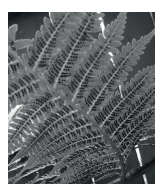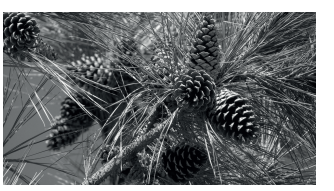Question
(a) The images show parts of plants belonging to two different phyla.
Plant X Plant Y


State the phylum of plant X and of plant Y. [2]
X:
Y:
(b) Some plant families, such as the figwort family, have been reclassified on the basis of evidence from cladistics. Explain the methods that have been used recently to reclassify groups of plants. [3]
(c) Successful sexual reproduction in flowering plants depends on several essential processes. Outline the role of pollination and seed dispersal. [2]
Pollination:
Seed dispersal:
▶️Answer/Explanation
Ans:
a X: Filicinophyta 2 Y: Coniferophyta/Conifera/Gymnosperms
b
a. «previous» classification used to be based on the appearance/structures of the plant/leaves/flowers/seeds/analogy/phenotype
b. «modern cladistics uses» RNA/DNA nucleotide/base sequencing/amino acid sequencing/homology
c. DNA mutation occurs at a relatively constant rate allowing estimation of when species
diverged
d. a shared/common derived characteristic places organisms in the same clade
e. the number of changes in sequences indicates distance from common ancestor OR the fewer the differences «in sequences» means the closer the relationship
c
pollination:
transfer/dispersal/movement of pollen from anther/stamen to stigma
OR
transfer/dispersal/movement of pollen between plants/flowers prior to/allowing
fertilization ✔
seed dispersal:
«strategy of» distribution of seeds so that new plants have space/nutrients to
develop/avoid competition/colonize new habitats ✔
Question
Distinguish between autotrophs and heterotrophs.
Define saprotroph.
State an external feature that is different in:
Cnidaria and Mollusca.
State an external feature that is different in:
Mollusca and Annelida.
▶️Answer/Explanation
Markscheme
autotrophs make their own food/organic molecules/organic matter and heterotrophs feed on/obtain their food/organic molecules from other organisms;
autotrophs use/require inorganic molecules/CO2 and heterotrophs require (complex) organic molecules;
an organism that lives on/in non-living/dead (organic) matter and secretes digestive enzymes/digestive juices into it / OWTTE
Cnidaria have radial symmetry while Mollusca have bilateral symmetry;
Cnidaria have tentacles/nematocysts/stinging cells while Mollusca do not;
Mollusca (may) have a (hard) shell while Cnidaria do not;
Mollusca have a mouth and anus while Cnidaria have only one opening;
Mollusca have a muscular/large foot while Cnidaria do not;
other valid external difference;
Annelida are segmented while Mollusca are not (visibly segmented);
Annelida may have bristles/chetae/chaetae while Mollusca do not;
Mollusca (may) have a (hard) shell while Annelida do not;
Mollusca have a muscular/large foot while Annelida do not;
other valid external difference;
Question
Evolution causes gene pools to change over time and new species to be formed.
(a) Outline how adaptive radiation provides evidence for evolution. [3]
(b) Describe polyploidy and how it can lead to speciation. [5]
(c) Explain how a newly discovered plant species would be classified and named. [7]
▶️Answer/Explanation
a a. diversification/ different species produced from a common/shared ancestor;
b. homologous features have similarities of structure
c. despite different functions;
d. (different) adaptation to different environments/different selective pressures;
e. pentadactyl limbs/Darwin’s finches/other example of adaptive radiation described correctly;
b a. polyploidy is having more than two (complete) sets of chromosomes/3n/4n/other specific example of polyploidy;
b. can be due to errors in meiosis/production of diploid gametes;
c. can be due to DNA replication without mitosis/cytokinesis;
d. polyploidy causes reproductive isolation;
e. diploids crossed with tetraploids produce infertile (triploid) offspring / triploid offspring are infertile;
f. tetraploids are therefore a new species/failure to interbreed/reproductive isolation leads to speciation;
g. (many) examples in the onion family/Allium/other valid example of speciation by polyploidy;
h. infertile interspecific hybrids can become fertile by becoming polyploid;
c Naming:
a. binomial nomenclature/(plant is) given a binomial/double name;
b. first name is the genus and second name is the species/genus initial upper case and species lower case;
c. names (of plant species) are international/are universally understood/are published in journals;
Classification:
d. study the characteristics/structure/reproduction/chemical properties/DNA (of the plant);
e. put/classify (the plant) in a group/genus with other similar species;
f. natural classification corresponds with evolution/natural classification is based on many features
g. analogous features/features due to convergent evolution should not be used;
h. hierarchy of groups/taxa (in traditional classification/3 or more taxa in correct sequence (kingdom-phylum-class);
i. two or more of bryophyta, filicinophyta, coniferophyta and angiospermophyta named;
j. a clade is a group of organisms evolved from a common ancestor;
k. base sequences/amino acid sequences used to group organisms into clades/deduce evolutionary relationships;
l. cladograms show the relationships between clades/likely evolutionary divergence of clades;
m. each branch point/node represents where species are formed via divergent evolution;
n. species are now classified into a sequence of clades (rather than a rigid hierarchy of taxa);